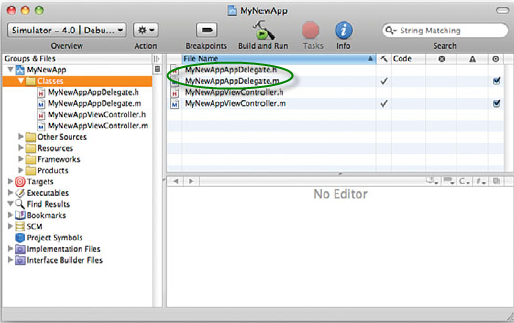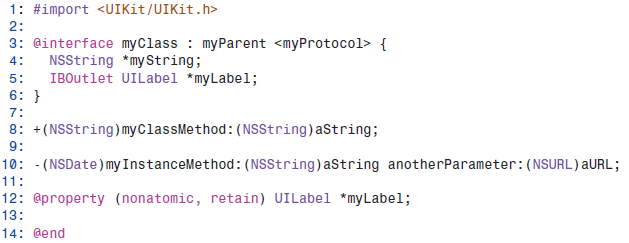Objective-C初步研究 - 接口文件(interface file)
1. Exploring the Objective-C File Structure
建立一个Objective-C的类会新建两个文件, 一个接口文件(头文件)(interface file), 后缀为.h,
一个实现文件(implementation file), 后缀为.m
(见下图)

顾名思义, 接口文件定义所有方法签名, 实现文件具体实现代码逻辑
看下面这段代码

#import语句用来导入某个头文件, 学过Java的朋友可以知道, 它类似Java中的import语句, 而Java中是导入某个包
Directive(指示语句)
Directives are commands that are added to your files that help Xcode and its
associated tools build your application.
(Directives你可以把它看成一种命令, 类似.NET中的@指示, 它让Xcode编译器知道你的代码如何组织)
NSString *myString;
IBOutlet UILabel *myLabel;
}
Protocol(协议)
Sometimes you will come across features that require you to write methods
to support their use—such as providing a list of items to be displayed in a
table. The methods that you need to write are grouped together under a common
name—this is known as a “protocol.”
(你可以把它想像成C#或者Java中的接口, 协议中定义了哪些方法, 你就需要去实现这些方法)
- (NSDate)myInstanceMethod:(NSString)aString anotherParameter:(NSURL)aURL;
The + denotes a class method(+号表示该方法是一个类方法)
- indicates an instance method(-号表示该方法是一个实例方法)
@property指示
如果程序要访问实例变量(instance variable), 如果你没有加入该指示, 必须使用get, set方法
你可以把该指示想像成.NET中的属性
原来使用get, set访问的代码
theCurrentLabel=[myLabel getText];
加了属性指示后, 我们可以像下面这样简单的访问
theCurrentLabel=myLabel.text;
这样就方便了很多
最后, 接口结束必须以结束指示符
@end



